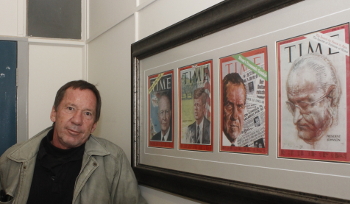Latest News Archive
Please select Category, Year, and then Month to display items
19 May 2021
|
Story Dr Nitha Ramnath

The University of the Free State (UFS), Standard Bank, and the
Mangaung Chamber of Commerce and Industry (MCCI) are pleased to invite you to a special lunchtime webinar with
Mr Allon Raiz, CEO of
Raizcorp, one of South Africa’s most successful business incubators.
The COVID-19 crisis has affected the operations, cash flow, and debt positions of most businesses, often threatening the sustainability and even the survival of businesses.
Join us for a discussion on how to think about business models that will ensure the survival and even the growth of business in the time of COVID-19.
Date: Thursday, 10 June 2021
Topic: Resilience and business in the time of COVID-19
Time: 12:00-13:30
Platform: Zoom
RSVP to:
Alicia Pienaar
by 7 June 2021
Photo manipulation in journalism: evil, crutch or lifebuoy?
2017-09-04

Albe Grobbelaar, veteran journalist and lecturer in the
Department of Communication Science at the UFS.
Photo: Rulanzen Martin
Since the 1800s the manipulation of photographs has been common practice, and who can forget the OJ Simpson Time magazine cover in 1994? Albe Grobbelaar, lecturer in the Department of Communication Science at the University of the Free State (UFS), asked in a special lecture on 18 August 2017 whether “Photo manipulation in Journalism” was an evil habit, a crutch or a lifebuoy.
“As a journalist I have always been interested in photography. And the principle of photo manipulation or tampering with photos, as we call it, is something that has interested me ever since,” Grobbelaar said. Photo manipulation is an area that has garnered many academic interest and is not a new trend but a practice that started in the 1830s when photos came into popular use. “It is not always done with ulterior motives, artists played with photographs to get unique effects.” Photo manipulation is not only to create fake news, but is sometimes used to convey novelty and create shock to news readers.
Different viewpoints for different circumstances
He talked about the spectrum of viewpoints on photo manipulation. Some conservative journalism schools say photos should never be retouched while other feel it is fine to tamper with pictures. “What I tried to convey in the lecture was that one should consider different circumstances differently,” Grobbelaar said. As a journalist he believes that news photos should never be manipulated.
He mentioned the example of the mugshot of OJ Simpson that the Los Angeles Police Department released to the media. “Newsweek and Time both used the photo on their front pages, but Time deliberately darkened the picture so that OJ, a black man, would appear more sinister,” Grobbelaar said. It is, however, common practice in the fashion industry to retouch images that are used in fashion magazines.
Use own judgment to validate photos
In the age of social media it has become easy to manipulate photos and which has been labelled fake news. “I would advise people to use their own judgment when validating the authenticity of photos,” Grobbelaar said. It is important to verify whether they are from a reliable news outlet.